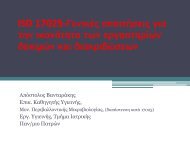Microbiological quality of indoor and outdoor swimming pools in ...
Microbiological quality of indoor and outdoor swimming pools in ...
Microbiological quality of indoor and outdoor swimming pools in ...
Create successful ePaper yourself
Turn your PDF publications into a flip-book with our unique Google optimized e-Paper software.
Results<br />
The microbiological <strong>quality</strong> <strong>of</strong> the <strong>in</strong>vestigated <strong>pools</strong><br />
was considered acceptable/unacceptable accord<strong>in</strong>g to<br />
the German st<strong>and</strong>ards DIN 19643 (DIN, 1984) <strong>and</strong> the<br />
British St<strong>and</strong>ard PAS39:2003 (BSI, 2003), the relevant<br />
Greek Regulation is old <strong>and</strong> needs updat<strong>in</strong>g (GHR,<br />
1973). The microbiological requirements accord<strong>in</strong>g to<br />
the German, British <strong>and</strong> Greek st<strong>and</strong>ards are presented<br />
<strong>in</strong> Table 1.<br />
Out <strong>of</strong> 462 water samples exam<strong>in</strong>ed, 310 (67%)<br />
conformed to the microbiological st<strong>and</strong>ards specified<br />
<strong>in</strong> Table 1, <strong>and</strong> 152 (32.9%) exceeded at least one <strong>of</strong> the<br />
<strong>in</strong>dicated limits. Salmonella, Mycobacterium, Legionella,<br />
Cryptosporidium <strong>and</strong> Giardia were not detected <strong>in</strong> any <strong>of</strong><br />
the samples analyzed. Total Heterotrophic counts<br />
exceeded 500 cfu/ml at 36 1C <strong>and</strong> 200 cfu/ml at 20 1C,<br />
<strong>in</strong> samples collected from the hydrotherapy pool<br />
dur<strong>in</strong>g the first two years <strong>of</strong> the study. From then<br />
onwards the THCs for the hydrotherapy pool from time<br />
to time were exceed<strong>in</strong>g the limit <strong>of</strong> 100 cfu/ml, but never<br />
exceeded the limits <strong>of</strong> the Greek st<strong>and</strong>ards. Escherichia<br />
coli, TC, FC <strong>and</strong> S. faecalis exceeded 0 cfu/100 ml only<br />
<strong>in</strong> samples collected from the hydrotherapy pool,<br />
whereas S. aureus exceeded 0 cfu/100 ml <strong>in</strong> samples<br />
from the competition pool, the children’s teach<strong>in</strong>g pool<br />
<strong>and</strong> the hydrotherapy pool. The percentages <strong>of</strong> conformity<br />
to the st<strong>and</strong>ard limits for the tested microbiological<br />
parameters <strong>in</strong> relation to the pool type are<br />
summarized <strong>in</strong> Table 2.<br />
P. aerug<strong>in</strong>osa was detected throughout the study <strong>in</strong> 3<br />
out <strong>of</strong> the 5 <strong>pools</strong> <strong>in</strong>vestigated; notably no Pseudomonas<br />
species was ever isolated from the competition public<br />
pool <strong>and</strong> the household private pool.<br />
ARTICLE IN PRESS<br />
C. Papadopoulou et al. / Int. J. Hyg. Environ.-Health 211 (2008) 385–397 389<br />
C<strong>and</strong>ida yeasts at concentrations 1–2 cfu/500 ml were<br />
detected <strong>in</strong> 15 samples (10.4%) from the hydrotherapy<br />
pool only. However, it has to be reported that<br />
C. albicans <strong>and</strong> C. tropicalis at concentrations exceed<strong>in</strong>g<br />
30 cfu/500 ml were isolated <strong>in</strong> two extra samples<br />
collected upon request <strong>of</strong> the hospital authorities<br />
<strong>and</strong> these f<strong>in</strong>d<strong>in</strong>gs co<strong>in</strong>cided with female bather’s<br />
compla<strong>in</strong>ts <strong>of</strong> hav<strong>in</strong>g vag<strong>in</strong>itis-like symptoms after<br />
attend<strong>in</strong>g hydrotherapy courses. Also <strong>in</strong> these two<br />
samples Aspergillus spp., Mucor spp., Alternaria spp.,<br />
Rhizopus spp., Penicillium spp. <strong>and</strong> Trichophyton spp.<br />
were detected. Due to this <strong>in</strong>cident the pool was closed<br />
down <strong>and</strong> comb<strong>in</strong>ed dis<strong>in</strong>fection with chlor<strong>in</strong>e (additional<br />
to ozone) was <strong>in</strong>itiated from then onwards <strong>and</strong><br />
f<strong>in</strong>ally the ozone dis<strong>in</strong>fection was replaced by a chlor<strong>in</strong>e<br />
only dis<strong>in</strong>fection system. No Dermatophytes were<br />
isolated <strong>in</strong> any samples <strong>of</strong> the rest <strong>pools</strong>. Table 3 shows<br />
the range <strong>of</strong> microbial contam<strong>in</strong>ation <strong>of</strong> the <strong>in</strong>vestigated<br />
<strong>pools</strong>.<br />
Among a total <strong>of</strong> 107 bacterial stra<strong>in</strong>s isolated from<br />
the five monitored <strong>swimm<strong>in</strong>g</strong> <strong>pools</strong>, 69 isolates were<br />
susceptible to all tested antibiotics <strong>and</strong> 38 isolates<br />
(35.5%) exhibited resistance to one or more antibiotics.<br />
S<strong>in</strong>gle resistance was observed <strong>in</strong> 3 stra<strong>in</strong>s (S. wernerii<br />
isolates from the competition pool) <strong>and</strong> multi-resistance<br />
<strong>in</strong> 35 stra<strong>in</strong>s (Pseudomonas alcaligenes, Leuconostoc<br />
<strong>and</strong> Staphylococcus aureus isolated from the teach<strong>in</strong>g<br />
pool, Chryseobacterium <strong>in</strong>dologenes <strong>and</strong> Ochrobactrum<br />
anthropi isolated from the competition pool, P. aerug<strong>in</strong>osa,<br />
P. fluorescens, A. hydrophila, S. aureus, Enterobacter<br />
cloacae <strong>and</strong> Klebsiella pneumoniae isolated from<br />
the hydrotherapy pool). Each pool type presented its<br />
own resistant bacterial flora, particularly the hydrotherapy<br />
pool, where all resistant isolates were common<br />
Table 1. <strong>Microbiological</strong> requirements for <strong>swimm<strong>in</strong>g</strong> pool water accord<strong>in</strong>g to German DIN 19643, BSI PAS 39:2003 <strong>and</strong> Greek<br />
Regulation 443/B/1974<br />
<strong>Microbiological</strong> requirement DIN 19643/1984 BSI PAS 39:2003 Greek St<strong>and</strong>ards Regulation 443/<br />
B/1974.<br />
Total heterotrophic counts at<br />
2072 1C<br />
o100 cfu/ml – 500 cfu/ml<br />
Total heterotrophic counts at<br />
3671 1C<br />
o100 cfu/ml o10 cfu/ml o200 cfu/ml<br />
Escherichia coli at 3671 1C Not detectable/100 ml Not detectable/100 ml Not <strong>in</strong>cluded <strong>in</strong> the regulation<br />
Total coliforms Not detectable/100 ml p10 cfu/100 ml o15 cfu/100 ml<br />
Fecal coliforms – – Absence/100 ml<br />
Pseudomonas aerug<strong>in</strong>osa at<br />
3671 1C<br />
Not detectable/100 ml Not detectable/100 ml 0 cfu/100 ml<br />
Legionella pneumonophila at<br />
3671 1C<br />
Not detectable/100 ml Not detectable/100 ml Not <strong>in</strong>cluded <strong>in</strong> the regulation<br />
Streptococcus faecalis – – Absence/100 ml<br />
Staphylococcus spp. – – Absence/100 ml<br />
Mycobacterium spp. – – Absence/1 l<br />
Pathogenic fungi – – Absence/100 ml



